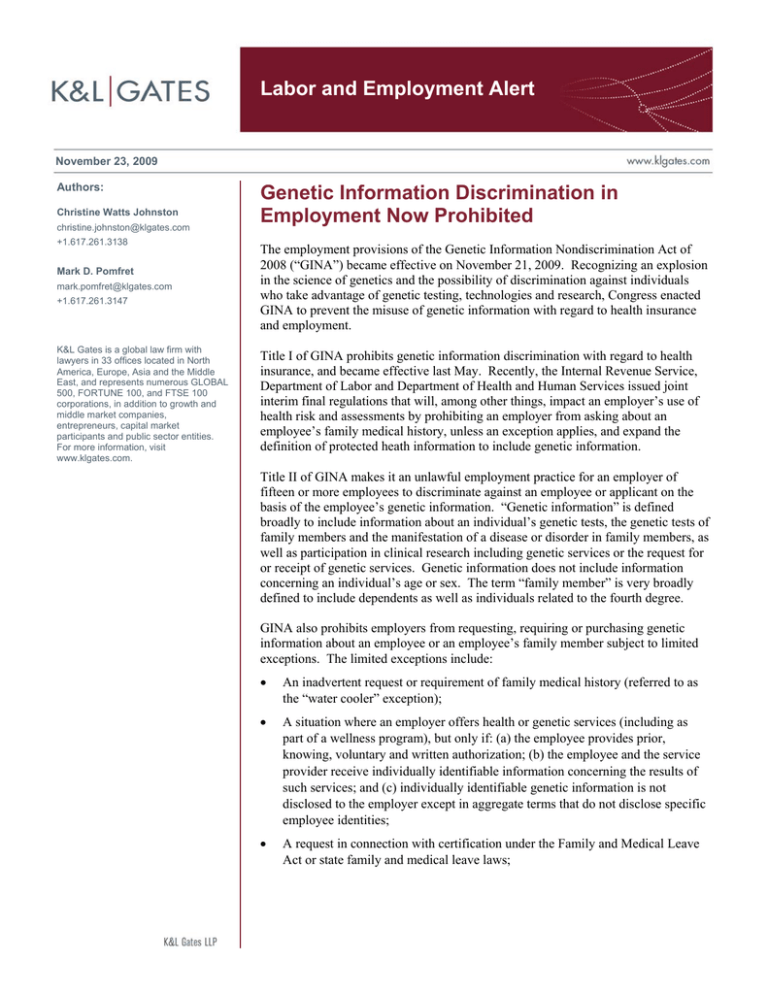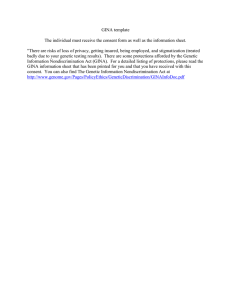
Labor and Employment Alert
November 23, 2009
Authors:
Christine Watts Johnston
christine.johnston@klgates.com
+1.617.261.3138
Mark D. Pomfret
mark.pomfret@klgates.com
+1.617.261.3147
K&L Gates is a global law firm with
lawyers in 33 offices located in North
America, Europe, Asia and the Middle
East, and represents numerous GLOBAL
500, FORTUNE 100, and FTSE 100
corporations, in addition to growth and
middle market companies,
entrepreneurs, capital market
participants and public sector entities.
For more information, visit
www.klgates.com.
Genetic Information Discrimination in
Employment Now Prohibited
The employment provisions of the Genetic Information Nondiscrimination Act of
2008 (“GINA”) became effective on November 21, 2009. Recognizing an explosion
in the science of genetics and the possibility of discrimination against individuals
who take advantage of genetic testing, technologies and research, Congress enacted
GINA to prevent the misuse of genetic information with regard to health insurance
and employment.
Title I of GINA prohibits genetic information discrimination with regard to health
insurance, and became effective last May. Recently, the Internal Revenue Service,
Department of Labor and Department of Health and Human Services issued joint
interim final regulations that will, among other things, impact an employer’s use of
health risk and assessments by prohibiting an employer from asking about an
employee’s family medical history, unless an exception applies, and expand the
definition of protected heath information to include genetic information.
Title II of GINA makes it an unlawful employment practice for an employer of
fifteen or more employees to discriminate against an employee or applicant on the
basis of the employee’s genetic information. “Genetic information” is defined
broadly to include information about an individual’s genetic tests, the genetic tests of
family members and the manifestation of a disease or disorder in family members, as
well as participation in clinical research including genetic services or the request for
or receipt of genetic services. Genetic information does not include information
concerning an individual’s age or sex. The term “family member” is very broadly
defined to include dependents as well as individuals related to the fourth degree.
GINA also prohibits employers from requesting, requiring or purchasing genetic
information about an employee or an employee’s family member subject to limited
exceptions. The limited exceptions include:
•
An inadvertent request or requirement of family medical history (referred to as
the “water cooler” exception);
•
A situation where an employer offers health or genetic services (including as
part of a wellness program), but only if: (a) the employee provides prior,
knowing, voluntary and written authorization; (b) the employee and the service
provider receive individually identifiable information concerning the results of
such services; and (c) individually identifiable genetic information is not
disclosed to the employer except in aggregate terms that do not disclose specific
employee identities;
•
A request in connection with certification under the Family and Medical Leave
Act or state family and medical leave laws;
Labor and Employment Alert
•
The purchase of commercially and publicly
available documents that include family medical
histories;
•
Circumstances where the information is to be
used for genetic monitoring of biological effects
of toxic substances in the workplace, but only if:
(a) the employer provides written notice to the
employee; (b) the employee provides prior,
knowing, voluntary and written authorization or
the genetic monitoring is required by law; (c)
the employee is informed of the results; (d) the
monitoring is compliant with applicable
regulations; and (e) the employer receives
results only in aggregate terms that do not
specifically identify any employee; or
•
A program whereby an employer conducts DNA
analysis and uses the genetic information for
quality control to detect sample contamination.
GINA applies not only to employers, but also to
employment agencies, labor organizations, and
training programs. The law provides that if an
employer does lawfully have covered genetic
information about an employee, the information
must be maintained in separate files and treated as
confidential medical information, consistent with the
provisions of the Americans with Disabilities Act.
The law also sets forth very limited circumstances
under which disclosure of genetic information is
allowed, such as in connection with the employee’s
compliance with the Family and Medical Leave Act
certification process, as part of an investigation into
compliance with GINA, or upon the written request
of the employee.
GINA prohibits retaliation based upon a complaint
about genetic discrimination or participation in an
investigation. The law provides a private cause of
action for retaliation and disparate treatment
because of genetic information. It also provides for
establishment of a commission within six years of
the effective date to review the status of the science
of genetics and make recommendations as to
whether a “disparate impact” cause of action should
be allowed as well.
To ensure compliance with GINA, employers
should examine and update their employment
policies and practices to make certain that
discrimination on the basis of genetic information is
prohibited as a matter of policy and in practice. The
Equal Employment Opportunity Commission
(“EEOC”) recently issued a revised Equal
Employment Opportunity is the Law poster, which
is available here. Employers also should reexamine
their practices regarding the maintenance of
employee files, including records that may include
genetic information. Wellness plans and protocols
should also be reviewed to be sure that they do not
violate the law. Finally, employers should consider
updating their training materials and internal
practices to ensure recognition of and compliance
with the new law.
The EEOC has issued proposed regulations for Title
II of GINA, which are not yet final. However, the
regulations concerning health insurance coverage
and group health plans under Title I are effective for
plan years beginning on or after December 7, 2009.
Anchorage Austin Beijing Berlin Boston Charlotte Chicago Dallas Dubai Fort Worth Frankfurt Harrisburg Hong Kong London
Los Angeles Miami Newark New York Orange County Palo Alto Paris Pittsburgh Portland Raleigh Research Triangle Park
San Diego San Francisco Seattle Shanghai Singapore Spokane/Coeur d’Alene Taipei Washington, D.C.
K&L Gates is a global law firm with lawyers in 33 offices located in North America, Europe, Asia and the Middle East, and represents numerous
GLOBAL 500, FORTUNE 100, and FTSE 100 corporations, in addition to growth and middle market companies, entrepreneurs, capital market
participants and public sector entities. For more information, visit www.klgates.com.
K&L Gates comprises multiple affiliated partnerships: a limited liability partnership with the full name K&L Gates LLP qualified in Delaware and
maintaining offices throughout the United States, in Berlin and Frankfurt, Germany, in Beijing (K&L Gates LLP Beijing Representative Office), in
Dubai, U.A.E., in Shanghai (K&L Gates LLP Shanghai Representative Office), and in Singapore; a limited liability partnership (also named K&L
Gates LLP) incorporated in England and maintaining offices in London and Paris; a Taiwan general partnership (K&L Gates) maintaining an office in
Taipei; and a Hong Kong general partnership (K&L Gates, Solicitors) maintaining an office in Hong Kong. K&L Gates maintains appropriate
registrations in the jurisdictions in which its offices are located. A list of the partners in each entity is available for inspection at any K&L Gates office.
This publication is for informational purposes and does not contain or convey legal advice. The information herein should not be used or relied upon
in regard to any particular facts or circumstances without first consulting a lawyer.
©2009 K&L Gates LLP. All Rights Reserved.
November 23, 2009
2




